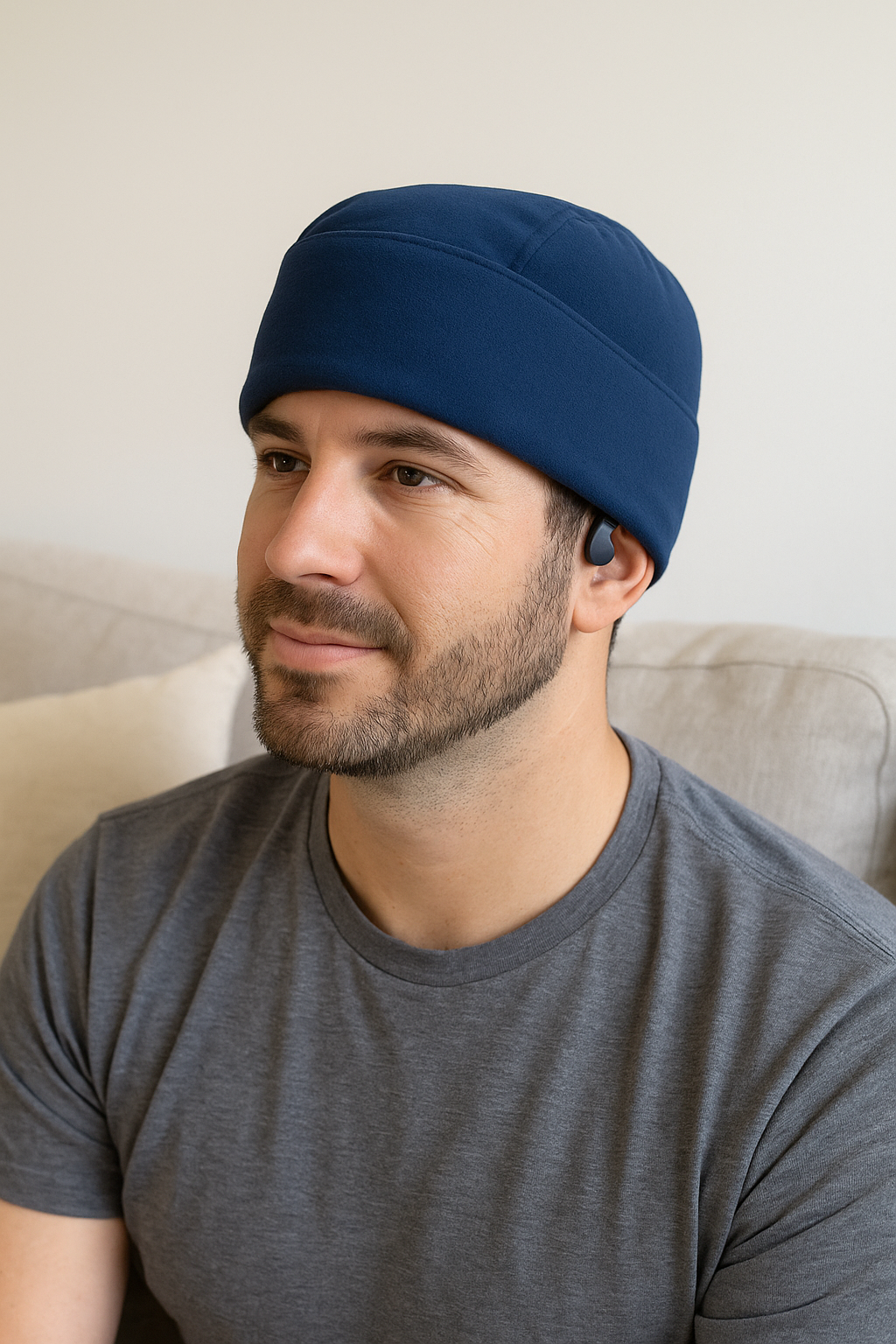Migraines can strike suddenly, bringing intense pain that disrupts your day. One of the most effective natural remedies is using a migraine relief cap, designed to apply soothing cold therapy directly to the head. However, to get the best results, it’s important to know how long to freeze a migraine cap before use. Freezing it too briefly won’t provide enough cooling power, while overfreezing can make it uncomfortable or even damage the gel inside.
In this guide, we’ll explain the ideal freezing time for a migraine cap, how to prepare it safely, and tips to keep it at the perfect temperature for fast and lasting pain relief.
How long should you freeze a migraine cap for optimal relief?
A migraine cap is one of the most effective and natural tools for easing the pain, pressure, and discomfort caused by migraines. But to experience its full benefits, it’s essential to use it at the right temperature and that starts with freezing it properly. The length of time you leave your migraine cap in the freezer can make all the difference between a soothing cooling effect and an uncomfortable, overly intense chill.
So, how long should you freeze your migraine cap for optimal relief? The answer depends on your cap’s design, the type of gel it contains, and your personal sensitivity to cold.
The ideal freezing time
Most high-quality migraine caps, such as those made with medical-grade gel, should be frozen for between 90 minutes and 2 hours to reach the perfect temperature. At this point, the gel becomes cold enough to deliver effective relief while staying flexible and comfortable to wear.
If you prefer a deeper cooling sensation, you can leave it in the freezer for up to 3 hours, but be cautious freezing it for too long may cause the gel to become excessively stiff, making the cap difficult to apply comfortably.
Once removed from the freezer, allow the cap to sit at room temperature for 1–2 minutes before placing it on your head. This helps balance the temperature and prevents skin irritation from direct contact with extreme cold.
Why the freezing duration matters
The temperature and consistency of the gel play a crucial role in how effectively the migraine cap works. If the cap is not cold enough, it won’t provide the numbing and vasoconstrictive effects that relieve migraine pain. On the other hand, if it’s too cold, it could cause discomfort or even mild skin irritation.
Freezing the cap for the right amount of time ensures the optimal cooling balance cold enough to reduce inflammation and calm nerves, but safe enough to protect your skin. This balance also prolongs the cooling effect, giving you 20–30 minutes of steady relief before the gel begins to warm up.
How to prepare your migraine cap
To achieve consistent results, follow these simple preparation steps:
-
Clean and dry the cap after each use. Any moisture or residue can freeze and create uneven cold spots.
-
Place it in a sealed bag before freezing to prevent it from absorbing odours or moisture from your freezer.
-
Store it flat rather than folded to maintain its ergonomic shape.
-
Avoid leaving it in the freezer for days at a time, as this can make the material brittle over time.
If you use your migraine cap regularly, it’s a good idea to keep it in the fridge between uses instead of refreezing it every day. This keeps it cool and ready for quick use, while extending its lifespan.
Adjusting based on sensitivity
Everyone experiences cold differently. If you’re sensitive to low temperatures or have delicate skin, start by freezing your migraine cap for 60 to 90 minutes to test your tolerance. If you find that the relief fades too quickly, gradually increase the freezing time until you find the perfect balance.
For those who prefer stronger, longer-lasting cold therapy, 2–3 hours of freezing should be sufficient. Just remember that comfort is key if your scalp feels uncomfortably cold or tingles too much, remove the cap immediately and wait a few minutes before reapplying.
Tips for maintaining optimal performance
-
Rotate between two caps if you experience frequent migraines. This allows one to freeze while the other is in use.
-
Do not overfreeze the gel, as it may harden and lose flexibility. A stiff cap will not fit comfortably and may fail to deliver even cooling.
-
Check the manufacturer’s instructions, as different brands use gels with varying freezing requirements. For example, the Sameo™ Migraine Relief Ice Cap reaches optimal flexibility and temperature after about 2 hours.
-
If you travel often, consider storing your migraine cap in a cooler bag or portable mini freezer to keep it ready for use wherever you are.
Why is it important to freeze a migraine cap properly?
Freezing a migraine cap properly may seem like a simple step, but it’s actually one of the most important factors in getting effective migraine relief. The temperature and consistency of the cap directly affect how well it soothes pain, reduces inflammation, and relaxes tense muscles. When frozen correctly, a migraine cap provides balanced, comfortable cooling that helps you manage symptoms safely and efficiently. When frozen incorrectly, however, it can lose its effectiveness or even cause discomfort.
Here’s why freezing your migraine cap the right way is essential for optimal performance and long-lasting relief.
Ensures the ideal temperature for pain relief
The main reason to freeze your migraine cap properly is to achieve the perfect therapeutic temperature. Migraine caps use medical-grade gel or gel beads that must be chilled to a specific level to activate their pain-relieving properties.
When cold therapy is applied at the right temperature typically between -5°C and 5°C it causes vasoconstriction, meaning the blood vessels in the head and temples narrow. This helps reduce the dilation that triggers throbbing migraine pain. The cold also numbs nerve endings, slowing pain signal transmission to the brain, which provides immediate relief.
If your cap isn’t frozen long enough, it won’t reach the right temperature to deliver this effect. You’ll feel mild cooling, but not enough to reduce inflammation or calm the nerves effectively. On the other hand, if it’s frozen for too long, it can become stiff, unevenly cold, or uncomfortably hard, making it difficult to wear and less efficient.
Freezing it properly ensures even cooling and consistent results every time you use it.
Maintains flexibility and comfort
Another key reason to freeze a migraine cap correctly is to preserve its flexibility. The soft, pliable design of migraine caps such as the Sameo™ Migraine Relief Ice Cap allows them to mould perfectly to your head, targeting pain zones around the forehead, temples, and neck.
If overfrozen, the gel inside becomes too rigid. Instead of fitting snugly against your head, the cap may feel bulky, uneven, or uncomfortable. In extreme cases, overfreezing can even cause the gel to crack or damage the internal structure of the cap, reducing its lifespan.
When frozen at the right temperature for 90 minutes to 2 hours, the cap remains soft and flexible. This ensures 360-degree coverage and a soothing, even cooling effect that supports both comfort and effectiveness.
Prevents skin irritation or frostbite
Freezing your migraine cap properly also helps protect your skin. When a cap is left in the freezer for too long, the gel can become excessively cold and rigid. Applying such a cap directly to your skin can cause cold burns or mild frostbite, especially in sensitive areas like the temples or around the eyes.
To avoid this, always make sure your cap is chilled, not frozen solid. If it feels too cold to the touch, let it rest at room temperature for one or two minutes before use. This allows the surface temperature to stabilise, giving you a safe and comfortable cooling experience.
It’s also important never to apply a frozen cap directly after removing it from the freezer especially if the manufacturer recommends using it at a lower chill level. Taking these small precautions ensures you get maximum relief without irritation.
Preserves the longevity of your migraine cap
A properly frozen migraine cap lasts longer. Consistent freezing and thawing cycles can weaken the materials over time if the cap isn’t stored correctly. Overfreezing causes micro-tears in the gel lining and damages the elasticity of the outer fabric. This can lead to uneven cooling or leakage after repeated use.
By freezing your cap for the right duration around 2 hours per use and avoiding long-term storage in extreme cold, you protect its integrity and ensure it stays effective for months or even years. Always store it in a sealed bag to prevent moisture build-up and odours from the freezer.
Delivers consistent and safe results
Ultimately, freezing your migraine cap correctly ensures that every time you use it, you get consistent, reliable relief. The cold remains steady, the compression feels balanced, and your skin stays protected. This consistency is what makes cold therapy one of the most dependable natural migraine treatments.
People who freeze their caps improperly often find that the temperature fluctuates too quickly or that the cooling effect fades unevenly. Proper freezing maintains the ideal balance between coldness and comfort, giving you up to 30 minutes of effective migraine relief per session.



How to use a cold cap for migraines?
Do orthopedic knee pillows work?